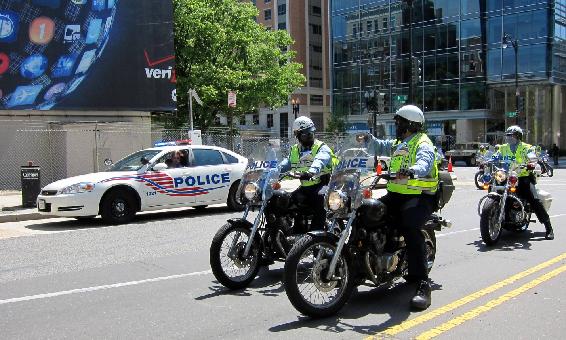10.9: Visible Presence
- Page ID
- 16151
Hot Spot Enforcement
A series of exhausting evaluations have indicated that police can be more effective in addressing crime and disorder when the focus is on smaller areas of geography with high crime rates. These areas are referred to as hot spots and policing strategies focus on these areas are usually referred to as hot spots policing. Hot spots policing includes a variety of police responses which all share a common focus of resources on the locations where crime is highly centered. The definition of hot spots varies from police agencies, from addresses, to certain street areas, to a clusters of street areas. The specific police tactics used to address high crime areas can very. There is not one way to implement hot spots policing, the approaches can be quite different from police agency to police agency.
The strategies of hot spot policing can be drastically increasing officer time spent at hot spots. The Minneapolis, Minnesota police department conducted a one-year randomized trial to determine the effect of increases in routine police patrols at crime hot spots. For this evaluation, crime hot spots would be small geographic areas of addresses with frequent crime calls. There were 110 hot spots established, with the largest frequency of crime calls between 7:00 pm and 3:00 am. The results showed a reduction in total crime calls from 6 to 13 percent. Police observed crime was only half as prevalent compared to the areas before the control hot spots were established. The greatest effects were on crimes of assault, person down, drug activity, solicitation for prostitution and vandalism. The Minneapolis findings support a hot spot police presence to lower overall crime rate in those targeted areas.
Hot spot policing can also take a complex approach in attempting to improve crime problems. In Jersey City, New Jersey, the police department examined the effects of problem-oriented policing interventions on violent crime problems. They identified violent crime hot spots using robbery and assault incidents and citizen calls for service data. The department then analyzed official data sources and discussing problems with community members, the department investigated the source and extent of the violent crime problems and developed appropriate problem-oriented responses. The analysis identified, 28 specific strategies across 12 intervention places, which can be defined as situational crime prevention interventions or as public order interventions.
Criminal incidents and calls for police service were significantly reduced at the intervention locations compared to the control places. Significant crime reduction took place in the areas of robbery, property crime, street mutual combat, and narcotics crimes. Overall calls and incident reports in total did not decline significantly, however officer’s observations suggested that physical and social disorder were affected in a positive manner at the intervention locations. No evidence was found to suggest the criminals re-located to a different location.
Motor Vehicle Enforcement
The American Association of State Highway and Transportation Officials (AASHTO) has determined that 93% of all traffic crashes are a direct result of some human factor and that 57% of all fatalities are a result of what could be considered High Risk Driving Behavior. High Visibility Enforcement (HVE) is a proven countermeasure and universal traffic-safety approach designed to create deterrence and change unlawful and risky driving behaviors. HVE combines highly visible and proactive law-enforcement strategies to target a specific traffic-safety issue. Law-enforcement efforts are combined with a marketing strategy to educate the public and promote voluntary compliance with the law. Specific deterrence is defined as the use of some form of punishment for unlawful activity that is intended to discourage a specific individual from re-offending. The objective of specific deterrence is to stop the immediate behavior and to persuade the person who committed the offense from breaking the law in the future.

Conversely, the concept of general deterrence is the overarching goal of HVE. General deterrence is intended to make motorists think twice about breaking the law. For example, drivers who are aware of Click-It-Or-Ticket campaigns and consistently see seatbelt enforcement during their morning commutes will be more likely to wear a seatbelt while driving as opposed to those who do not. Overall, increased public awareness about enforcement efforts will ultimately change risky driving behavior. Increased squads conducting enforcement in a targeted area to gain voluntary compliance of traffic laws and create general deterrence to prevent traffic violations. Increased enforcement must be visible to the motoring public, they need to see officers making traffic stops. This method has proven effective in reducing traffic and DUI related accidents and fatalities.
In this exercise, we will look at skills and techniques we can develop to improve our ability to resolve conflicts. We are going to break into groups and identify recent conflicts we have experienced in our personal life. You will be asked to identify trigger words or situations that escalated the problem. Then, your partner will offer a suggestion on how you could have resolved the situation.
Step 1:
Create a conflict sheet (Identify 3 Incidents)
|
Subject of Conflict |
People Involved |
Incident |
Trigger Word |
|
|---|---|---|---|---|
|
1 |
||||
|
2 |
||||
|
3 |
Step 2:
In groups of FOUR read your conflict sheet, and the person to the left will provide possible solutions to the incident. Continue around the circle with each person providing and incident and providing a solution.
Step 3:
As an officer, conflicts arise daily. Officers often have to help others resolve conflict. How did this activity help you think through other people’s conflicts? Did you feel comfortable providing solutions? Why or why not?
Step 4:
How did this class help you resolve conflicts?

